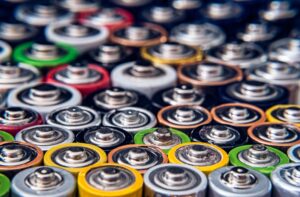Energy Storage Technologies:
- Long Duration Storage Technologies
- Solid State Battery Technologies
- LLZO Based Solid State Battery Technologies
- Hydrogen Technologies
- Thermal Storage Technologies
- Lithium-Ion Battery Technologies
- Lithium-Sulfur Battery Technologies
- Recyclable Battery Technologies
Long Duration Storage Technologies
Longer Cycle Life, Lower Cost All-Organic Redox Flow Batteries (2016-126)
This invention pairs redox-active oligomers with size-selective, porous membranes that block the migration of active molecules while allowing the transport of supporting ions. The technology demonstrated a 9000-fold reduced rate of active material loss compared to traditional separators, offering a solution for low cost, long duration energy storage.
Inventor: Brett Helms Contact: Shanshan Li
Cerium Hydrogen Redox Flow Batteries (2016-051)
This invention optimizes cell materials, electrolyte composition, and operating protocol to make the cerium-hydrogen redox flow cell a good candidate for large scale energy storage. The flow cell can also be used in chemical production methods in which the Ce4+ ion is produced electrochemically.
Inventor: Michael Tucker
Contact: Shanshan Li
Soluble Redox Mediators for Metal-Sulfur Batteries for Efficient Charge Transfer (2014-148)
This invention is a class of self-assembled organic semiconductor nanowires for liquid or flow-based electrochemical cells. These nanowires have three-dimensional electrical conductivity and self-healing properties.
Inventor: Brett Helms
Contact: Shanshan Li
Flow-Through Battery Electrode for Long Duration Energy Storage (2022-038)
This invention is a new electrode design to Ni-Zn flow batteries that significantly increases the energy density. The design makes electrode production easily scalable for grid-scale long duration storage, and the elimination of separators from the cell design makes the electrodes directly recyclable at end-of-life.
Inventor: Daniel Collins-Wildman
Contact: Shanshan Li
Ceramic Composite for High-Temperature Thermal Energy Storage (2022-031)
This invention is a conductive ceramic composite material that can store energy as heat up to 1800 oC for tens to hundreds of hours. The material can be charged efficiently via Joule heating and then the energy can be discharged either directly as heat or converted back to electricity through thermophotovoltaics or an appropriate heat engine.
Inventor: Sean Lubner
Contact: Shanshan Li
Composite Material for Salt Hydrate Thermochemical Energy Storage (2022-148)
This invention is a composite material for stable, long-term thermochemical energy storage that can be fabricated through a dry-mixing process. The dry-mixing process is scalable and eliminates the agglomeration problem that reduces the cycling stability of other thermochemical energy storage materials, demonstrated in the stable performance of this material for over 500 cycles.
Inventor: Andrew Martin
Contact: Shanshan Li
Solid State Battery Technologies
Dual Charge Conducting Polymer Binder (2023-034)
This invention is a cost-effective dual charge conducting polymer that enhances the performance of lithium-ion batteries when used with silicon, tin, or graphite-based electrodes, offering improved conductivity for both ions and electrons without compromising other essential binder properties.
Inventor: Gao Liu
Contact: Shanshan Li
Miscible Polymer Blend Electrolytes: A New Material for High-Performance, Safer Lithium and Solid State Batteries (2020-060)
This invention is the first electrolyte made as a blend of two miscible polymers, opening the door to creating new electrolyte mixtures. Polymer electrolytes like this are important for the development of safer, solid-state batteries.
Inventor: Nitash Balsara
Contact: Shanshan Li
High-Energy and High-Power Composite Cathodes for All-Solid-State Batteries (2021-176)
This invention includes halide solid electrolytes and single crystal cathodes to make high energy and high power density batteries. Due to being single crystals, these cathodes resist mechanical breakdown, giving them high rate capability and good cycling stability.
Inventor: Guoying Chen
Contact: Shanshan Li
Layered/Rock Salt Intergrown Electrodes for Rechargeable Batteries (2018-142)
This invention is a new type of cathode for lithium-ion batteries that combines the advantages of both layered oxide and disordered rocksalt materials. The rocksalt structure prevents the mechanical degradation of the layered oxide, stabilizing it without reducing the capacity or impacting the favorable kinetics expected from a layered oxide cathode.
Inventor: Wei Tong
Contact: Shanshan Li
High-Energy Li-rich Cathodes for Increased Energy Efficiency in Batteries (2021-168)
This invention introduces cation disordering into layered, Li-rich cathode materials, significantly increasing the energy density. Additionally, these cathodes show <0.1% capacity fade per cycle over 100 cycles, showcasing the material’s incredible cycling stability.
Inventor: Jianping Huang
Contact: Shanshan Li
Supramolecular Solid Electrolytes for Recyclable Batteries (2023-061)
This invention is a supramolecular organo-ionic (ORION) electrolyte for use in lithium batteries. At operating temperatures the electrolyte is a viscoelastic solid, but over 100 oC it becomes a viscoelastic liquid, making for easy fabrication and direct cathode recycling at the end of the cell’s life.
Inventor: Brett Helms
Contact: Shanshan Li
Manganese-Rich Partially-Disordered Cathode (2023-055)
This invention is a cathode material created by inducing a phase transformation within a disordered rocksalt cathode. By inducing short range order, the material gains the stability seen in some ordered cathode materials, boasting up to 92% capacity retention over 100 cycles.
Inventor: Zijian Cai
Contact: Shanshan Li
LLZO Based Solid State Battery Technologies
Fabrication of Architecturally Controlled Electrolyte Frameworks For Solid-State Batteries (2019-177)
Berkeley Lab researchers have addressed challenges in fabricating all-solid-state batteries (ASSBs) with ceramic electrolytes by employing tape-casting and freeze tape casting (FTC) methods to create bi-/tri-layer frameworks, enabling scalable production of thin porous films with improved control over pore characteristics. The researchers achieved successful room temperature cycling of bulk-type ASSBs using these compositions, overcoming previous limitations and offering potential applications in next-generation energy storage devices for mobile electronics, electric vehicles, and grid energy storage.
Inventor: Marca M Doeff
Contact: Shanshan Li
Enabling Porous Ceramic (LLZO) Electrodes for Solid State Batteries through Tapecasting (2020-061, 2020-117)
Researchers at Berkeley Lab have developed technologies to overcome challenges in fabricating porous ceramic LLZO electrode and dense electrolyte layers for lithium solid-state batteries. The innovations include LLZO-compatible binder systems for tapecasting, addressing issues of reactivity with LLZO particles, and new processes (phase inversion and high shear compaction) for fabricating thick porous LLZO-based solid-state electrodes, enabling improved energy density by creating a porous scaffold supporting a thin densified electrolyte.
Inventor: Michael C Tucker
Contact: Shanshan Li
Battery cell with organic cathode and solid electrolyte (2022-130)
Berkeley Lab researchers have explored the use of the lithium garnet solid electrolyte (LLZO) in a hybrid battery cell, allowing the consideration of cathode active materials like quinones that offer high specific capacities but are typically incompatible with conventional liquid electrolyte-based cells. In this setup, a solid electrolyte/liquid catholyte hybrid battery features metallic Li alloy as the anode, lawsone (a biologically-derived quinone) as the cathode, and LLZO as the separator, effectively preventing the dissolved cathode material from reaching the anode, thus addressing capacity degradation issues associated with liquid electrolytes.
Inventor: Michael C Tucker
Contact: Shanshan Li
Hydrogen Technologies
High Performance Anion Exchange Membrane for Fuel Cells (2014-151)
This invention is an anion exchange membrane capable of replacing Nafion, the current membrane standard. This membrane demonstrates comparable conductivity and superior, low H2 permeability to Nafion.
Inventor: Siwei Liang
Contact: Shanshan Li
Graphene Oxide / Metal Nanocrystal Multilaminates for Safe, Selective Hydrogen Storage (2015-017)
This invention is an environmentally stable material with dense hydrogen storage capability that can be straightforwardly synthesized in solution. The end result is a multilaminate of reduced graphene oxide (rGO) sheets filled with magnesium nanocrystals, where the rGO sheets act as protective layers, allowing easy hydrogen penetration and enhancing H2 absorption and desorption.
Inventor: Jeff Urban
Contact: Shanshan Li
Thermal Storage Technologies
Thermal Energy Storage System (2019-142)
This invention is a dynamically tunable thermal energy storage system that can be applied to the surfaces of buildings, vehicles, and medical devices to reduce energy consumption. The system changes the transition temperature of a phase change material to expand the effective temperature range beyond what is normally accessible for phase change materials.
Inventor: Sumanjeet Kaur
Contact: Shanshan Li
Ceramic Composite for High-Temperature Thermal Energy Storage (2022-031)
This invention is a conductive ceramic composite material that can store energy as heat up to 1800 oC for tens to hundreds of hours. The material can be charged efficiently via Joule heating and then the energy can be discharged either directly as heat or converted back to electricity through thermophotovoltaics or an appropriate heat engine.
Inventor: Sean Lubner
Contact: Shanshan Li
Composite Material for Salt Hydrate Thermochemical Energy Storage (2022-148)
This invention is a composite material for stable, long-term thermochemical energy storage that can be fabricated through a dry-mixing process. The dry-mixing process is scalable and eliminates the agglomeration problem that reduces the cycling stability of other thermochemical energy storage materials, demonstrated in the stable performance of this material for over 500 cycles.
Inventor: Andrew Martin
Contact: Shanshan Li
Lithium-Ion Battery Technologies
Dual Charge Conducting Polymer Binder (2023-034)
This invention is a cost-effective dual charge conducting polymer that enhances the performance of lithium-ion batteries when used with silicon, tin, or graphite-based electrodes, offering improved conductivity for both ions and electrons without compromising other essential binder properties.
Inventor: Gao Liu
Contact: Shanshan Li
Silicic Acid, Silicate, Metasilicate, and Salts as Electrolyte Additives for Lithium-Ion Batteries (2022-068)
This invention uses silicic acid, silicate, and metasilicate salts as electrolyte additives to improve low temperature performance, operating at almost 75% of the room temperature capacity while at -20 oC. Unlike other additives for low temperature performance, these don’t compromise performance at higher temperatures.
Inventor: Gao Liu
Contact: Shanshan Li
Novel Conductive Polymer Binders for Next-generation Lithium Batteries (2021-035)
This invention is a functional conductive polymer designed for use as a binder in silicon-based electrodes. The polymer formulation is highly conductive and has strong adhesion to the electrode materials, greatly improving cycling stability in the face of the large volume changes observed in Si-based anodes.
Inventor: Gao Liu
Contact: Shanshan Li
Lithium-Sulfur Battery Technologies
Novel High-Sulfur Utilization Electrolytes for Lithium-Sulfur Batteries (2019-169)
This invention is a bifunctional electrolyte molecule that forms a micelle structure. The inside of these micelles hold and transfer lithium ions while sulfur has limited solubility in the bulk electrolyte solvent.
Inventor: Gao Liu
Contact: Shanshan Li
Dissolvable Crosslinked Polymer Binder for Battery Electrode Recycling (2020-089)
This invention is an ionic polymer binder for sulfur cathodes that enables both high sulfur loading and good cycling stability. It is also the first report of a recyclable Li-S battery, building towards sustainable energy and a circular battery economy.
Inventor: Gao Liu
Contact: Shanshan Li
Mixed Electrolyte for Li-S Batteries for Transportation Applications (2022-018)
This invention is a formulation of an amphiphilic micelle electrolyte with an additive to further reduce polysulfide dissolution. This formulation shows greatly improved cycling stability over typical electrolytes for lithium-sulfur batteries.
Inventor: Gao Liu
Contact: Shanshan Li
Recyclable Battery Technologies
Dissolvable Crosslinked Polymer Binder for Battery Electrode Recycling (2020-089)
This invention is an ionic polymer binder for sulfur cathodes that enables both high sulfur loading and good cycling stability. It is also the first report of a recyclable Li-S battery, building towards sustainable energy and a circular battery economy.
Inventor: Gao Liu
Contact: Shanshan Li
Supramolecular Solid Electrolytes for Recyclable Batteries (2023-061)
This invention is a supramolecular organo-ionic (ORION) electrolyte for use in lithium batteries. At operating temperatures the electrolyte is a viscoelastic solid, but over 100 oC it becomes a viscoelastic liquid, making for easy fabrication and direct cathode recycling at the end of the cell’s life.
Inventor: Brett Helms
Contact: Shanshan Li
Flow-Through Battery Electrode for Long Duration Energy Storage (2022-038)
This invention is a new electrode design to Ni-Zn flow batteries that significantly increases the energy density. The design makes electrode production easily scalable for grid-scale long duration storage, and the elimination of separators from the cell design makes the electrodes directly recyclable at end-of-life.
Inventor: Daniel Collins-Wildman
Contact: Shanshan Li

